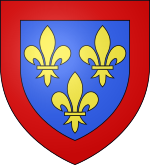Bourbon Anjou
The Bourbon-Anjou house was initially a side branch and has been the oldest branch of the Bourbon house since 1883 . The Bourbons, in turn, are a branch of the Capetian royal family, which has ruled France since the early Middle Ages . Ever since Robert the Brave († 866), the Capetians had provided the Counts and Dukes of Anjou in various lines .
Since the House of Bourbon-Anjou is the kings of Spain to this day , it is also known as the "House of Spain" or the "Spanish line of the Bourbons" (span: Borbón).
history
This Bourbon branch was founded by Philippe de Bourbon, duc d'Anjou , (1683–1746) a grandson of King Louis XIV of France . After the death of the last Spanish king from the house of the Habsburgs , Charles II , the Duc d'Anjou succeeded him on the throne as Philip V (Felipe.) According to the will (drawn up by the Spanish government) of the late Charles II V.) - but on the condition that there should never be a partition of Spain (as originally agreed by Louis XIV with England) and never a personal union between Spain and France. In the War of the Spanish Succession , this change of rule was defended against the Austrian Habsburgs and their German-British-Dutch allies.
In 1713, Philip V declared an express renunciation of the throne for France in the Treaty of Utrecht , thereby establishing the “House of Spain” of the Bourbons. Louis XIV then reassigned the title Duc d'Anjou , to his great-grandson, the future Louis XV. During his minority, the French regent Philippe II. De Bourbon, duc d'Orléans 1717–1720 led the war of the Quadruple Alliance against Bourbon Spain.
Philip V's descendants are the kings of Spain to this day . Furthermore, other branches of this family split off, such as the Bourbons in the Kingdom of the Two Sicilies (House Bourbon-Sicily ) and in the Duchy of Parma (House Bourbon-Parma ). The present Grand Dukes of Luxembourg descend from the latter .
Since the French main branch of the Bourbons died out in 1883 with Henri de Bourbon-Artois, comte de Chambord , the Spanish line moved to the top of the Bourbon family because of its position as the next branch in the agnatic tribe (male tribe). At the same time, the senior of the Spanish Bourbons is also the senior of the Capetian sex ("House of France"), which is why he is recognized by the legitimist wing of the French monarchists as their pretender to the French throne, in competition with the House of Orléans , and regardless of Article VI of the Treaty of Utrecht of 1713, in which the then Duc d'Anjou dropped his (and his descendants) right of inheritance to the French throne because of his ascension to the Spanish throne. The current senior capet from the Spanish branch is Louis Alphonse de Bourbon , who uses the title “duc d'Anjou” to substantiate his claim to the throne in France against his competitors from the Orléanist camp . Louis Alphonse would also be King of Spain today, or would have been included in the succession to the Spanish throne, had his grandfather Jaime de Borbón not ceded his inheritance claims to his nephew King Juan Carlos I in 1969 .
The Kings of Spain from the House of Borbón

- Philip V , 1700-1724
- Ludwig I. , 1724
- Philip V , 1724-1746
- Ferdinand VI. , 1746-1759
- Charles III , 1759-1788
- Charles IV , 1788-1808
- Ferdinand VII. , March – May 1808 and 1813–1833
- Isabella II , 1833-1868
- Alfonso XII , 1874-1885
- Alfonso XIII , 1886-1931
- Juan Carlos I , 1975-2014
- Felipe VI. , since 2014
Extract from the family table of the Bourbons (Spanish line)
|
Philip V (1683-1746) |
|||||||||||||||||||||||||||||||||||||
|
Ludwig I (1707-1724) |
Ferdinand VI. (1713–1759) |
Charles III (1716–1788) |
Philip of Parma (1720–1765) |
||||||||||||||||||||||||||||||||||
|
House Bourbon-Parma (until today) |
|||||||||||||||||||||||||||||||||||||
|
Charles IV (1748-1819) |
Ferdinand I of Sicily (1751-1825) |
||||||||||||||||||||||||||||||||||||
|
Ferdinand VII (1784-1833) |
Carlos María Isidro de Borbón (1788–1855) |
Francisco de Paula de Borbón (1794–1865) |
House of Bourbon-Sicily (until today) |
||||||||||||||||||||||||||||||||||
|
Isabella II (1830-1904) |
Francisco de Asís de Borbón (1822–1902) |
||||||||||||||||||||||||||||||||||||
|
Carlos Luis de Borbón (1818–1861) |
Juan Carlos de Borbón (1822-1887) |
||||||||||||||||||||||||||||||||||||
|
Carlos María de Borbón (1848–1909) |
Alfonso Carlos de Borbón (1849-1936) |
Alfonso XII (1857-1885) |
|||||||||||||||||||||||||||||||||||
|
Jaime de Borbón (1870-1931) |
Alfonso XIII (1886–1941) |
||||||||||||||||||||||||||||||||||||
|
Jaime de Borbón (1908-1975) |
Juan de Borbón (1913–1993) |
||||||||||||||||||||||||||||||||||||
|
Alfons Jaime de Borbón (1936–1989) |
Juan Carlos I (1938) |
||||||||||||||||||||||||||||||||||||
|
Luis Alfonso de Borbon (1974) |
Felipe VI. (1968) |
||||||||||||||||||||||||||||||||||||
|
Leonor (2005) |
|||||||||||||||||||||||||||||||||||||
Residences
The official residence is the Madrid Palacio Real , in whose representative rooms the state receptions take place and which - in addition to the museum wings - houses the Royal Court Office. Private residences of the royal family are now the more modest Palacio de la Zarzuela on the outskirts and a summer palace in Palma . The tomb of the kings is in the Escorial . The former summer palace El Pardo is now used as a guest house for state visits, the royal palaces of Aranjuez , La Granja , Riofrio and the Palacio Real de La Almudaina in Palma belong to the Patrimonio Nacional and are open to the public as museums, the Alcázar of Seville is also a museum and royal secondary residence.
El Escorial , burial place of the house
Palacio Real (El Pardo) , guest castle
Palacio Real de La Almudaina in Palma









